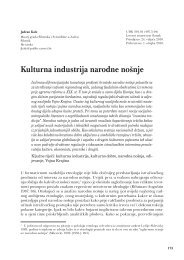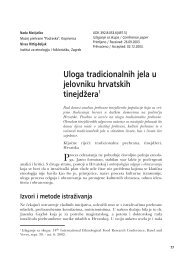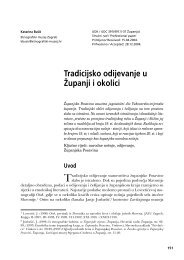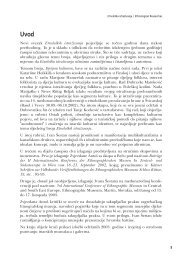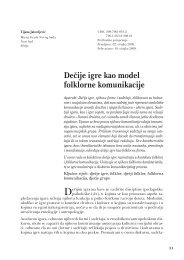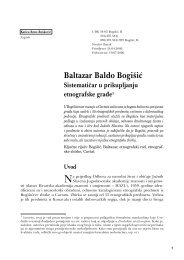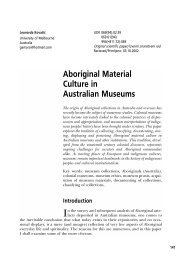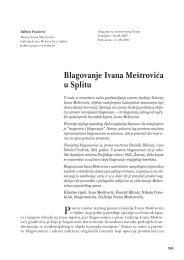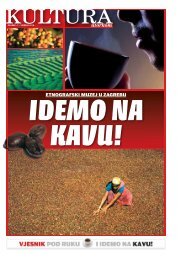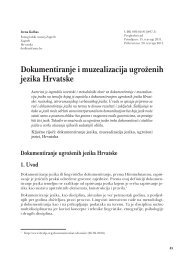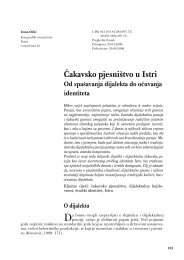Kuhinja, blagovanje, prehrana u plemićkoj palači u 18. st ... - EMZ
Kuhinja, blagovanje, prehrana u plemićkoj palači u 18. st ... - EMZ
Kuhinja, blagovanje, prehrana u plemićkoj palači u 18. st ... - EMZ
You also want an ePaper? Increase the reach of your titles
YUMPU automatically turns print PDFs into web optimized ePapers that Google loves.
Fani Celio Cega<br />
Muzej grada Trogira<br />
Trogir<br />
Izlaganje sa znan<strong>st</strong>venog skupa<br />
Primljeno: 20.07.2007.<br />
Prihvaćeno: 10.08.2007.<br />
<<strong>st</strong>rong>Kuhinja</<strong>st</strong>rong>, <<strong>st</strong>rong>blagovanje</<strong>st</strong>rong>,<br />
<<strong>st</strong>rong>prehrana</<strong>st</strong>rong> u <<strong>st</strong>rong>plemićkoj</<strong>st</strong>rong> <<strong>st</strong>rong>palači</<strong>st</strong>rong><br />
u <<strong>st</strong>rong>18.</<strong>st</strong>rong> <strong>st</strong>. – ideja za novi <strong>st</strong>alni<br />
po<strong>st</strong>av u Muzeju grada<br />
Trogira<br />
U članku je na primjeru palače Garagnin opisan izgled kuhinje i blagovaonice<br />
te način prehrane u Trogiru. U <<strong>st</strong>rong>palači</<strong>st</strong>rong>, koja se i<strong>st</strong>odobno<br />
obnavljala i djelomično gradila polovicom <<strong>st</strong>rong>18.</<strong>st</strong>rong> <strong>st</strong>., danas je udomljen<br />
Muzej grada Trogira. Autorica iznosi ideje za uređenje novoga <strong>st</strong>alnog<br />
po<strong>st</strong>ava Muzeja kojim bi se predočila svakodnevica onoga doba<br />
glede kuhinje i blagovaonice.<br />
Ključne riječi: Muzej grada Trogira, obitelj Garagnin, kuhinja,<br />
blagovaonica, <<strong>st</strong>rong>prehrana</<strong>st</strong>rong>, muzejski po<strong>st</strong>av<br />
Muzej grada Trogira smješten je u <<strong>st</strong>rong>palači</<strong>st</strong>rong> čiji se jedan<br />
dio gradio polovicom <<strong>st</strong>rong>18.</<strong>st</strong>rong> <strong>st</strong>., dok se drugi u tom i<strong>st</strong>om<br />
razdoblju obnavljao. Nekoć je pripadala uglednoj <<strong>st</strong>rong>plemićkoj</<strong>st</strong>rong> obitelji Garagnin, koja je,<br />
u duhu onoga vremena, živjela od pomorske trgovine i poljoprivrede u gradu što je<br />
pomorskim putem bio vezan za prekomorsku Italiju, a kopnenim sa zaleđem. I jedno<br />
i drugo utjecalo je na svakodnevicu grada ne samo u pogledu opreme kuća, odijevanja,<br />
zabave, nego i prehrambenih navika, opreme kuhinje i blagovanja. Budući da su<br />
Garagnini, kolekcionari, sve sakupljali te se sačuvao njihov obiteljski arhiv, uključujući<br />
nacrte palače, danas nam je poznato gdje se nalazila kuhinja, gdje pro<strong>st</strong>orija u kojoj<br />
se mijesio i čuvao kruh, gdje se blagovalo te gdje se čuvala hrana. 1<br />
1 Opširnije o obitelji i <<strong>st</strong>rong>palači</<strong>st</strong>rong> u knjizi Celio Cega, 2005., te iz literature na kraju knjige: l89-199.<br />
285
286<br />
Etnološka i<strong>st</strong>raživanja/Ethnological Researches<br />
<<strong>st</strong>rong>Kuhinja</<strong>st</strong>rong><br />
<<strong>st</strong>rong>Kuhinja</<strong>st</strong>rong> se nalazila na najvišem katu palače. Taj je smještaj određen u kućama još<br />
od vremena srednjega vijeka 2 zbog sigurno<strong>st</strong>i od požara te kako se mirisi od kuhanja<br />
ne bi širili kućom i smetali gospodarima. U kuhinji su se nalazili naslonjači i sjedalice,<br />
škrinje i škrinjice u kojima su se držale namirnice i posuđe te feral. 3 Usporedbe<br />
radi, tijekom 17. <strong>st</strong>. u susjednoj Italiji u kuhinjskim se škrinjama zajedno čuvalo i<br />
rublje i sir. 4 Osamnae<strong>st</strong>o <strong>st</strong>oljeće bilo je donekle urednije, iako ne previše, pa se u kuhinji<br />
svega moglo naći.<br />
U neposrednoj je blizini kuhinje pro<strong>st</strong>orija koja se u inventarima nazivala salvarobba.<br />
U njoj se mijesio kruh, a služila je i kao o<strong>st</strong>ava za kruh. Zabilježeno je u njoj više manjih<br />
<strong>st</strong>olova za odlaganje kruha, veliki <strong>st</strong>ol na kojemu se mijesilo, škrinje u kojima se<br />
čuvalo brašno, sijalo za brašno, ovalne posude i drvo za miješenje itd. 5<br />
Komin na kojemu se kuhalo vidi se na sačuvanim nacrtima u Muzeju grada Trogira<br />
(Sl. 1). 6 U sačuvanoj arhivskoj građi s kraja <<strong>st</strong>rong>18.</<strong>st</strong>rong> <strong>st</strong>. nabrajaju se uporabni kuhinjski<br />
predmeti u kući: 7 mlinci za kavu, broštulin za prženje kave, brončani svijećnjaci i svjetiljke<br />
– lumette, lume, kace i pripadajuće velike žlice za juhu – kacjole, kotačić za rezanje<br />
tije<strong>st</strong>a – rodela, kalupi za tortu – tortiere, posude – pinjate, lončići za kavu – kogome, za<br />
čokoladu, sijalo, kuhinjska vaga, kaca za vodu, posuda u kojoj se pere suđe, lijevak,<br />
drvene žličice, ribež, lonci (bronzini), različita željeza za kuhinju, kalup za puding –<br />
budin, željezni kalup za rožadu, željezna tava – padela itd. U kući je te godine bilo do<strong>st</strong>a<br />
keramičkog posuđa – zdjela, tanjura, posuda – pinjata, za maslo i dr. 8<br />
Kuhinjsko su posuđe Garagnini nabavljali ili u domaćih proizvođača ili su ga, kao i<br />
druge potrepštine za kuću, uvozili iz Italije.<br />
Podrumskih pro<strong>st</strong>orija za čuvanje hrane bilo je nekoliko. Bile su namijenjene pravljenju<br />
i čuvanju vina, ulja, sira u rasolu (salamuri), pa je u njima bilo raznog pribora<br />
za preradu vina i ulja, alata itd. 9<br />
Pri nedavnoj obnovi i sanaciji krovišta palače potvrđeno je da se kuhinja nalazila<br />
upravo tamo gdje je na <strong>st</strong>arom nacrtu bila predviđena. 10 Naime, na trećem katu u<br />
niskom potkrovlju pronađeni su o<strong>st</strong>aci dimnjaka, a cijeli je tavanski pro<strong>st</strong>or bio crn<br />
od čađi. Nakon što se obnova Muzeja privede kraju, pri<strong>st</strong>upit će se izradi novog po<strong>st</strong>ava<br />
pri čemu bi valjalo voditi računa i o rekon<strong>st</strong>rukciji nekadašnje kuhinje. Doduše,<br />
originalnoga kuhinjskog inventara iz palače nema, ali mogao bi se sakupiti, otkupiti<br />
ili nabaviti prema sačuvanim opisima kako bi se barem donekle pred<strong>st</strong>avila onodobna<br />
kuhinja.<br />
2 Marasović, 1994: 197.<br />
3 Cega, 1996: 582., Celio Cega, 2005: 95.<br />
4<br />
Sarti, 2006: 148.<br />
5 Celio Cega, 2005: 95-96.<br />
6<br />
Celio Cega, 2005: 54.<br />
7<br />
DAS, AFG, PO 2/I „A“<br />
8<br />
Objašnjenja pojedinih izraza u Geić – Slade – Šilović, 1994.<br />
9<br />
Celio Cega, 2005: 96.
Fani Celio Cega: <<strong>st</strong>rong>Kuhinja</<strong>st</strong>rong>, <<strong>st</strong>rong>blagovanje</<strong>st</strong>rong>, <<strong>st</strong>rong>prehrana</<strong>st</strong>rong> u <<strong>st</strong>rong>plemićkoj</<strong>st</strong>rong> <<strong>st</strong>rong>palači</<strong>st</strong>rong> u <<strong>st</strong>rong>18.</<strong>st</strong>rong> <strong>st</strong>. – ideja za novi <strong>st</strong>alni po<strong>st</strong>av u Muzeju grada Trogira<br />
U posljednje se vrijeme muzeološka <strong>st</strong>ruka trudi prikazati originalne interijere dvoraca.<br />
Tako je, primjerice, u obnovljenoj kraljevskoj <<strong>st</strong>rong>palači</<strong>st</strong>rong> u Višegradu, u kojoj je djelo<br />
svojih ruku o<strong>st</strong>avio glasoviti hrvatski kipar Ivan Duknović, predočen izgled kuhinje<br />
onako kako se moglo pretpo<strong>st</strong>aviti da je izgledala. Palača je srušena u turskim napadima<br />
na Mađarsku, a obnovljena je na temelju sačuvanih o<strong>st</strong>ataka, zapisa i literature.<br />
Kuhinjski inventar vrlo je skroman, ali je na uvodnoj legendi crtežom predočena<br />
<strong>st</strong>ara kuhinja i priprema jela u njoj. 11<br />
Blagovaonica<br />
Blagovaonica na prvome katu palače, između podrumskih pro<strong>st</strong>orija i kuhinje, bila<br />
je bogato namještena. U sredini pro<strong>st</strong>orije dominirao je velik okrugli <strong>st</strong>ol s četrnae<strong>st</strong><br />
sjedalica (careghine). 12 Bila su tu i dva <strong>st</strong>olića, veći i manji tipa tavolin, te dvije komode<br />
i jedan otoman. Neposredno uz nju, bila je manja pro<strong>st</strong>orija u kojoj se na policama<br />
nalazio pribor za jelo, porculan i <strong>st</strong>aklo. 13 U kući Garagnina krajem <<strong>st</strong>rong>18.</<strong>st</strong>rong> <strong>st</strong>. nalazila<br />
se velika količina flandrijskih <strong>st</strong>olnjaka od dama<strong>st</strong>a s pripadajućim ubrusima, za<br />
12 i 24 osobe s velikim <strong>st</strong>olnjakom u jednome komadu, <strong>st</strong>olnjaka od venecijanske tele<br />
i pripadajućih ubrusa, <strong>st</strong>olnjaka za komode, lanenih <strong>st</strong>olnjaka i ubrusa, manjih <strong>st</strong>olnjaka<br />
za komode itd. 14<br />
Porculan, <strong>st</strong>aklo te pribor za jelo redovito su se dobavljali iz Italije. Inače ga je Europa<br />
dobivala iz Kine, a glavno je uvozno središte dugo vremena bio London. 15 Kava se<br />
i u Trogiru če<strong>st</strong>o konzumirala. Odatle i veliko zanimanje za šalice za kavu, čaj te čokoladu.<br />
16 Crna kava pila se u manjim šalicama, a s mlijekom u većim. U posebnima<br />
se pio čaj. Čokolada je uz kavu bila omiljeni napitak onodobnoga visokog društva. 17<br />
Primjerice, iz godine 1801. sačuvao se pregledni popis porculana i kri<strong>st</strong>ala koji sadrži<br />
više velikih oktogonalnih tanjura različitih veličina, zdjela za juhu s poklopcem, okruglih<br />
tanjura, također različitih veličina, bijele lavore i vrč ukrašen cvjetićima, noćne<br />
posude od majolike na cvjetiće, tzv. gatti di Boemia (figurice od porculana u obliku<br />
mačke) te i<strong>st</strong>e takve kri<strong>st</strong>alne. Nabrajaju se i kri<strong>st</strong>alni predmeti: bocuni, soljenke, manje<br />
kri<strong>st</strong>alne boce (bocete) za <strong>st</strong>ol s poklopcem, te bez poklopca, posuda za voće (sortu)<br />
s manjom bocom (bocetom) s poklopcem, boce u obliku mačke za liker s podnoškom –<br />
Boemia, jedan bocun, te razne vr<strong>st</strong>e boca. Nabrajaju se šalice s tanjurićima ukrašenim<br />
crvenim cvjetićima, one za čokoladu ukrašene na i<strong>st</strong>i način, pa takve za kavu; pripadajuća<br />
šećernica, kogome za kavu, oktogonalni tanjur sa zlatnim rubom, velike šalice s<br />
10 Cega, 1998: 110.<br />
11<br />
Buzás, 2001: 11-15.<br />
12 Objašnjenje pojedinih riječi u Boerio, 1971.<br />
13<br />
Celio Cega, 2005: 64.<br />
14 DAS, AFG, PO 2/I „A“<br />
15<br />
Sarti, 2006: 124, 146-147.<br />
16<br />
Celio Cega, 2005: 100-101; Božić – Bužančić, 1976: 60.<br />
17 Sarti, 2006: 209.<br />
287
288<br />
Etnološka i<strong>st</strong>raživanja/Ethnological Researches<br />
poklopcem i bez poklopca, drveni poslužavnici, mesingani svijećnjaci (di otton), uljanice,<br />
ručni i zidni ferali. I<strong>st</strong>e, 1801. godine, Garagnini su napravili popis obiteljske srebrnine<br />
u kojem su naveli: košarice za kruh, šećernicu, žličice s dužom ručkom za sok,<br />
još jednu šećernicu srednje veličine, male žličice, hvataljke za šećer (molettine), svijećnjake,<br />
mačetu s držačem, soljenke, posudu za držanje voća na <strong>st</strong>olu (sortur), tintarnicu,<br />
vaze za cvijeće, šalicu za juhu s tanjurićem, grijač za ruke (škaldaman), svjetiljku<br />
(fioretinu), podmetače za boce, dva kompleta: žlicu, nož i vilicu (trinzanti), manju žlicu<br />
za vađenje juhe, jednu za ribu, dvije za juhu, pribor za jelo s navlakom za 12 osoba<br />
te još jedan za 12 i dva za 6 osoba 18 (usp. slike 2, 3, 4, 5).<br />
Po završetku obnove Muzeja, po<strong>st</strong>oji i mogućno<strong>st</strong> uređenja blagovaonice. Namještaj<br />
koji joj je pripadao nije sačuvan, ali po<strong>st</strong>oji drugi koji je kasnije otkupljen za potrebe<br />
Muzeja i koji bi se mogao iskori<strong>st</strong>iti za novi po<strong>st</strong>av. Po<strong>st</strong>av <strong>st</strong>ola mogao bi se opremiti<br />
porculanom i <strong>st</strong>aklom – za svečane prigode, primjerice u ljetnoj sezoni, a skromnije<br />
s, primjerice, keramičkim tanjurima u zimskom razdoblju itd. Na takav bi se način<br />
po<strong>st</strong>igla raznoliko<strong>st</strong> i izbjegla monotonija <strong>st</strong>alnog po<strong>st</strong>ava.<br />
Prehrana<br />
Plem<strong>st</strong>vo se, sudeći po sačuvanim računima kuće Garagnin, 19 hranilo svim vr<strong>st</strong>ama<br />
mesa do kojeg je moglo doći: govedinom, teletinom, svinjetinom, janjetinom ili bravetinom,<br />
kozletinom, piletinom te mesom od divljači spremljenim na razne načine. Riba<br />
se jela prema sezoni lova: brancini, orade, škarpine, salpe, srdele, palamide, barbuni,<br />
oslići, li<strong>st</strong>ovi i dr., zatim lignje te razne vr<strong>st</strong>e rakova (škampi, grancigule za brudet).<br />
Jele su se jegulje (anguje) koje su se ubacivale u bunare da bi či<strong>st</strong>ile vodu. Če<strong>st</strong>o je na<br />
jelovniku bio bakalar kuhan na bjanko ili na brudet, a dodavalo bi mu se sušeno crno<br />
grožđe. Jele su se razne vr<strong>st</strong>e tje<strong>st</strong>enina: špageti, makaroni s raznim umacima, če<strong>st</strong>o<br />
s umakom od rajčica, pa tagliatele, lazanje (če<strong>st</strong>o s mladim bobom) itd. Povrće se spremalo<br />
prema sezoni – krumpir, cvjetača, kupus, kelj, šparoge, rajčice, artičoke, zelena<br />
salata, radič i dr. Uglavnom se kuhalo i jelo začinjeno maslinovim uljem koje se uvijek<br />
obilato rabilo. Drugog ulja nije bilo, nego samo svinjske ma<strong>st</strong>i. Od svinjetine jele<br />
su se posebne male kobasice – luganige, koje su se pravile čim bi svinju zaklali, i to s<br />
rižotom od iznutrica. Ovu vr<strong>st</strong>u kobasica spominje glasoviti arhitekt Tomas Graham<br />
Jackson. 20 Bilo je pršuta, slanine, raznih vr<strong>st</strong>a salame koja se uvozila. Jelo se sezonsko<br />
svježe voće, te kuhano u kompotu ili sušeno (kao prilog jelu i za kolače). Od voća spominju<br />
se jabuke, kruške, šljive (svježe ili suhe), smokve (svježe ili suhe), grožđe, dunje,<br />
naranče, limuni, bademi, lješnjaci i dr. Kori<strong>st</strong>ile su se i razne mirodije, uglavnom papar,<br />
klinčić i cimet. Mlijeko i mliječni proizvodi, pogotovo razne vr<strong>st</strong>e sireva, maslo,<br />
skuta itd., konzumirali su se u većim količinama. Ljeti se pilo bijelo vino, a zimi crno<br />
18 DAS, AFG, ADS 12/V.<br />
19 DAS, AFG, ADS 4/VIII.<br />
20 Dalmatia, the Quarnero and I<strong>st</strong>ria, Oxford 1887., T. II: 117.
Fani Celio Cega: <<strong>st</strong>rong>Kuhinja</<strong>st</strong>rong>, <<strong>st</strong>rong>blagovanje</<strong>st</strong>rong>, <<strong>st</strong>rong>prehrana</<strong>st</strong>rong> u <<strong>st</strong>rong>plemićkoj</<strong>st</strong>rong> <<strong>st</strong>rong>palači</<strong>st</strong>rong> u <<strong>st</strong>rong>18.</<strong>st</strong>rong> <strong>st</strong>. – ideja za novi <strong>st</strong>alni po<strong>st</strong>av u Muzeju grada Trogira<br />
i opol. Od likera, uživalo se u maraskinu, pelinkovcu, rakiji, prošeku itd. 21 Na i<strong>st</strong>i se<br />
način jelo u susjednom Splitu te u o<strong>st</strong>alim gradovima u Dalmaciji. 22<br />
Kolači su bili prigodni. Za blagdan Svih svetih spremali su se bobići (fave); za Božić<br />
kolači od badema i meda (kolači forte, u Splitu su ih nazivali buzzolaima), kotonjata od<br />
dunja ili mošta (slatko koje se radilo iskuhavanjem dunja ili mošta, šećera i dodataka,<br />
a potom se ulijevalo u posebne kalupe; ohlađeno, i<strong>st</strong>reslo bi se iz kalupa i položilo<br />
na li<strong>st</strong> lovora i tako čuvalo, obično na velikoj dasci po ormarima kamo bi se <strong>st</strong>avljale<br />
i dunje), rafijoli, kroštule (u Trogiru su ih zvali kokrlama, a vuku podrijetlo od karnevala<br />
u Veneciji), fritule ... Za Uskrs su se spremale sirnice i garitule (sirnica u obliku<br />
pletenice s umetnutim tvrdo kuhanim jajem). Tijekom godine uglavnom su se pravile<br />
torte, primjerice, trogirska torta i razne vr<strong>st</strong>e suhih kolača itd. 23<br />
Zaključak<br />
Kako bi se dočarale prehrambene navike u kući Garagnin, u originalnom interijeru<br />
palače, odnosno <strong>st</strong>alnom po<strong>st</strong>avu Muzeja mogle bi se u kuhinji i blagovaonici po<strong>st</strong>aviti<br />
makete hrane izrađene od prirodnih materijala (papira, gipsa, drveta). Izložena<br />
jela na <strong>st</strong>olu za <<strong>st</strong>rong>blagovanje</<strong>st</strong>rong> mogla bi se prema sezoni mijenjati kako bi se izbjegla jednolično<strong>st</strong>.<br />
Na sličan je način pred<strong>st</strong>avljena hrana u spomenutome kraljevskom dvorcu<br />
u Višegradu te u nekim muzejima u sjevernoj Hrvatskoj.<br />
Kako rečeni muzejski pro<strong>st</strong>ori ne bi služili isključivo za razgledavanje, oni bi se mogli<br />
oživjeti tako da se u njima organiziraju svečane večere koje bi oponašale one koje<br />
su se održavale u <<strong>st</strong>rong>palači</<strong>st</strong>rong> tijekom <<strong>st</strong>rong>18.</<strong>st</strong>rong> <strong>st</strong>oljeća, i to za ekskluzivne go<strong>st</strong>e (primjerice, za<br />
samo jednu obitelj, da ne bi došlo do zloporabe). Večeru bi posluživala primjereno<br />
odjevena „posluga“, a i go<strong>st</strong>i bi se mogli odjenuti po ondašnjoj modi. Tu se već može<br />
dati mašti na volju pa je potrebno razmotriti svrhu i smisao tih aktivno<strong>st</strong> kako se ne<br />
bi povrijedila in<strong>st</strong>itucija muzeja.<br />
21 Celio Cega, 2005: 105-110.<br />
22 Zglav – Martinac, 1997.<br />
23 Celio Cega, 2005: 110-112.<br />
289
290<br />
Etnološka i<strong>st</strong>raživanja/Ethnological Researches<br />
Literatura<br />
Boerio, G. (1971.) Dizionario del dialetto Veneziano, Tipografia di Giovanni Cecchini<br />
edit, Milano<br />
Božić-Bužančić, D. (1976) Društveni i privatni život u Splitu od konca XVIII. <strong>st</strong>oljeća do<br />
pada Mletačke Republike, Školska knjiga, Split<br />
Buzás, G. (2001) The Hercules Fountain of Giovanni Dalmata in the Royal Palace of Visegrád.,<br />
Budape<strong>st</strong> – Visegrád , Mátyás Király Múzeum TKM Egyesület<br />
Cega, F. (1998) Radovi na zaštiti muzejske građe u Muzeju grada Trogira, u: Informatica<br />
museologica, 29(3-4), Zagreb, <strong>st</strong>r. 108-111.<br />
Celio Cega, F. (2005) Svakidašnji život grada Trogira od sredine <<strong>st</strong>rong>18.</<strong>st</strong>rong> do sredine 19. <strong>st</strong>oljeća,<br />
Književni krug, Split<br />
Geić, D. – Slade – Šilović, M. (1994) Rječnik trogirskog cakavskog govora, Muzej grada<br />
Trogira, Trogir<br />
Marasović, T. (1994) Stambena kuća u Trogiru Radovanova doba, u: ur. I. Babić, Maj<strong>st</strong>or<br />
Radovan i njegovo doba, Trogir, <strong>st</strong>r. 193-201<br />
Sarti, R. (2006) Živjeti u kući. Stanovanje, <<strong>st</strong>rong>prehrana</<strong>st</strong>rong> i odijevanje u novovjekovnoj Europi<br />
(1500.-1800.), Ibis grafika, Zagreb<br />
Zglav – Martinac, H. (1997) Tako su jeli naši <strong>st</strong>ari (Katalog izložbe), Muzej grada Splita,<br />
Split<br />
Kratice<br />
DAS, AFG = Državni arhiv Splita, Arhiv Fanfogna – Garagnin
Fani Celio Cega: <<strong>st</strong>rong>Kuhinja</<strong>st</strong>rong>, <<strong>st</strong>rong>blagovanje</<strong>st</strong>rong>, <<strong>st</strong>rong>prehrana</<strong>st</strong>rong> u <<strong>st</strong>rong>plemićkoj</<strong>st</strong>rong> <<strong>st</strong>rong>palači</<strong>st</strong>rong> u <<strong>st</strong>rong>18.</<strong>st</strong>rong> <strong>st</strong>. – ideja za novi <strong>st</strong>alni po<strong>st</strong>av u Muzeju grada Trogira<br />
6.01 6.02 6.03<br />
6.04 6.05<br />
291
Fani Celio Cega<br />
Museum of the Town of Trogir<br />
Gradska vrata 4<br />
21220 Trogir<br />
Conference paper<br />
Received: July 20, 2007.<br />
Accepted: Augu<strong>st</strong> 10, 2008.<br />
Kitchen, Dining and Diet in<br />
the 18 th Century Ari<strong>st</strong>ocratic<br />
Palace – a Proposal for the<br />
New Permanent Exhibition<br />
in the Museum of the Town<br />
of Trogir<br />
The author in this article described the kitchen and the dining room<br />
of the Garagnin palace and, in connection to that, the typical 18 th century<br />
diet of the town of Trogir. The house, which was simultaneously<br />
renovated and partially built in the middle of the 18 th century, is today<br />
the home of the Museum of the Town of Trogir. The author presented<br />
her own proposals for the e<strong>st</strong>ablishment of the new permanent exhibition<br />
in the Museum which would present everyday life of the time and<br />
the region, concerning kitchen and dining.<br />
Key words: Museum of the Town of Trogir, the Garagnin<br />
family, kitchen, dining room, diet, museum exhibition<br />
The Museum of the Town of Trogir is situated in the palace<br />
one wing of which was built in the middle of the<br />
18th century, while another wing was being renovated in the same period. It once belonged<br />
to a prominent ari<strong>st</strong>ocratic family Garagnin which lived, as it was cu<strong>st</strong>omary<br />
then, on sea trade and agriculture in a town which was connected by a sea route to<br />
Italy and by a continental road to the hinterland. Both routes influenced everyday<br />
life of the town not only in household inventory, clothing and pass time, but also in<br />
diet, kitchen utensils and dining. Since the Garagnin family were also passionate collectors,<br />
collecting everything and therefore preserving a rich family archive, including<br />
the palace drawings and maps, today we know the exact position of the kitchen,<br />
293
294<br />
Etnološka i<strong>st</strong>raživanja/Ethnological Researches<br />
the room where bread was made and preserved, where people were eating, or where<br />
the food was kept. 1<br />
Kitchen<br />
The kitchen was situated at the topmo<strong>st</strong> floor of the palace. This position was e<strong>st</strong>ablished<br />
in the palaces since medieval times (Marasović 1994:197) because of the risk<br />
of fire and so that the kitchen smells would not spread around the house and di<strong>st</strong>urb<br />
the house ma<strong>st</strong>ers. The kitchen was furnished with chairs and armchairs, che<strong>st</strong>s and<br />
drawers for preservation of food and a feral (Cega 1996:582, Cega 2005:95). Ju<strong>st</strong> for<br />
comparison, during the 17 th century in the neighboring Italy people used to keep underwear<br />
and cheese all together in one che<strong>st</strong> (Sarti 2006:148). The 18 th century was<br />
somewhat more pri<strong>st</strong>ine, but not too much, and hence all kinds of items could be<br />
found in the kitchen.<br />
In the immediate vicinity of the kitchen there was a room which was called in the inventories<br />
salvarobba. It was used for making and preserving bread. It was noted that<br />
it contained a number of smaller tables for placing bread rolls, a large table for making<br />
dough, che<strong>st</strong>s in which flour was kept, elliptic dishes and wooden shovels, etc<br />
(Cega 2005:95-96).<br />
The fireplace which was used for cooking can be seen in the preserved drawings in<br />
the Museum of the Town of Trogir (Picture 1) (Cega 2005:54). In the preserved archival<br />
material from the end of the 18 th century, many household items that were used<br />
in the kitchen were enumerated 2 : coffee grinders, broštulin for roa<strong>st</strong>ing coffee beans,<br />
bronze candle<strong>st</strong>icks and lamps – lumette, lume, pots (kace) and the accompanying large<br />
soup spoons - kacjole, pa<strong>st</strong>ry wheel – rodela, cake moulds – tortiere, pots – pinjate, coffee<br />
pots – kogome, chocolate pots, sifter, kitchen scale, water bucket, dish washing container,<br />
funnel, wooden spoons, graters, pots (bronzini), different kitchen utensils made of<br />
iron, pudding mould- budin, iron mould for rožada, iron frying pan – padela, etc. According<br />
to the archival material it seemed that there were a lot of ceramic pots in the<br />
house that year – cups, plates, pots – pinjata, used for butter, etc. 3<br />
The Garagnins were buying their kitchen tableware from either dome<strong>st</strong>ic producers<br />
or they were importing them from Italy, together with other household supplies.<br />
There were several rooms in the basement that were used as food <strong>st</strong>orages. They were<br />
mainly used for production and preservation of wine, as <strong>st</strong>orages for oil or cheese in<br />
1 More details on the family and the palace can be found in the 2005 book written by Celio Cega (check<br />
the reference li<strong>st</strong> at the end of this article) and from the extensive bibliography found at the end of that<br />
book, pages 189-199.<br />
2 DAS, AFG, PO 2/I „A”<br />
3 Detailed explanations of specific names can be found in Geić – Slade – Šilović, 1994.
Fani Celio Cega: Kitchen, Dining and Diet in the 18 th Century Ari<strong>st</strong>ocratic Palace – a Proposal for the New Permanent Exhibition<br />
in the Museum of the Town of Trogir<br />
brine (salamura) and they contained various tools and pieces of equipment for manufacturing<br />
wine and oil (Cega 2005:96).<br />
During recent roof repair work and renovation, it was confirmed that the kitchen was<br />
situated exactly at the same position which was specified in the old building plan (Cega<br />
1998:110). Chimney remains were found on the third floor in the low attic space and<br />
the whole attic was blackened by soot. After the Museum re<strong>st</strong>oration will be completed,<br />
the new permanent exhibition should be designed and the recon<strong>st</strong>ruction of the<br />
old kitchen should also be included in the project. The original palace kitchen inventory<br />
is, unfortunately, gone, but similar items could be collected, according to the<br />
descriptions of the original ones found in the preserved documents, then bought off<br />
or purchased, and, to a certain level, they could present the original outlook of the<br />
kitchen of that period.<br />
A new trend in the museum science is to present the original interiors of different ca<strong>st</strong>les.<br />
For example, in the renovated royal palace in Višegrad, in the creation of which<br />
the famous Croatian sculptor, Ivan Duknović, participated, the kitchen was recon<strong>st</strong>ructed<br />
on the basis of hypotheses and ideas as to what the kitchen looked like in its<br />
original outlook. The palace was de<strong>st</strong>royed during Ottoman raids on Hungary and it<br />
was renovated on the basis of the preserved documents, writings and literature. The<br />
presented kitchen inventory is very mode<strong>st</strong>, but the introductory museum descriptions<br />
contain the drawings of the original kitchen and the ways in which food was<br />
prepared (Buzás 2001:11-15).<br />
Dining room<br />
The dining room was situated on the fir<strong>st</strong> floor of the palace, between the basement<br />
and the kitchen, and it was richly furnished. A large dining table with fourteen chairs<br />
(careghine) 4 occupied the central position in the room. Two coffee tables, a bigger and<br />
a smaller one of the tavolin type, two che<strong>st</strong>s of drawers and one sofa were also there.<br />
Next to the dining room, there was a smaller room with shelves and closets used for<br />
cutlery, porcelain and glass (Cega 2005:64). At the end of the 18 th century in the Garagnin<br />
house there was a rich collection of Flanders damask tablecloths with matching<br />
napkins, sets for 12 and 24 people with large one-piece tablecloths, tablecloths<br />
made of Venetian telah with matching napkins, tablecloths for che<strong>st</strong>s, flax tablecloths<br />
and napkins, etc. 5<br />
Porcelain, glass and cutlery were regularly shipped from Italy. European countries<br />
were importing there products from China at the time and the main import center<br />
was London (Sarti 2006:124, 146-147). Coffee was also commonly used in Trogir.<br />
Therefore coffee cups, together with tea and chocolate cups were important household<br />
4<br />
Detailed explanations of specific names can be found in Boerio, 1971.<br />
5 DAS, AFG, PO 2/I „A”<br />
295
296<br />
Etnološka i<strong>st</strong>raživanja/Ethnological Researches<br />
items (Cega 2005: 100-101, Božić-Bužančić 1976:60). Black coffee was enjoyed in smaller<br />
cups, and café latte in larger cups. Special cups were used for drinking tea. Next<br />
to coffee, chocolate was the mo<strong>st</strong> favorite drink among the members of the high society<br />
of the period (Sarti 2006:209). For example, there is a preserved li<strong>st</strong> of porcelain<br />
and china dating from 1801 which enumerates a number of octagonal plates of<br />
different sizes, a soup bowl with a lid, a number of round plates, also of different sizes,<br />
white wash-basins, jugs decorated with flowers, majolica chamber-pots decorated<br />
with flowers, the so-called gatti di Boemia (porcelain figurines shaped like cat), also<br />
made from cry<strong>st</strong>al. Many cry<strong>st</strong>al items are also enumerated: bocuni, salt-cellars, smaller<br />
cry<strong>st</strong>al bottles (bocete) with or without lid which were kept on the table, fruit bowl<br />
(sortu) with the matching bottle (boceta) with a lid, liqueur bottles shaped like cat with<br />
horizontal base – Boemia, one bocun and different types of bottles. Cups with matching<br />
plates decorated with small red flowers are also enumerated, chocolate cups decorated<br />
in the same way, as well as coffee cups, the matching sugar dish, kogome for<br />
coffee, octagonal plate with the golden rim, large cups with or without lids, wooden<br />
trays, brass candle<strong>st</strong>icks (di otton), oil lamps, lanterns and hanging lamps (ferali). In<br />
the same year, 1801, the Garagnins made a li<strong>st</strong> of their family silverware which contained:<br />
bread baskets, sugar-dish, small spoons with long handle for juice, another<br />
smaller sugar-dish, small spoons, sugar clamps (molettine), candle <strong>st</strong>icks, large kitchen<br />
knife with a handle, salt-cellars, fruit bowl for the table (sortur), inkpot, flower vase,<br />
small soup bowl with the plate, hand heater (škaldaman), lamp (fioretina), bottle pads,<br />
two cutlery sets: spoon, knife and fork (trinzanti), smaller ladle, fish spoon, two soup<br />
spoons, cutlery with protective cover for twelve, another one for twelve persons and<br />
two for six persons 6 (compare Pictures 2,3,4, and 5).<br />
After the renovation of the Museum is completed, there is also a possibility of recon<strong>st</strong>ructing<br />
the dining room. The original furniture is not preserved, but there is another<br />
set of furniture which has been bought off for the Museum and which could be<br />
used for the exhibition. The central table could be decorated with porcelain and glass<br />
used in formal occasions during the summer months and during winter periods it<br />
could be decorated in a more mode<strong>st</strong> fashion, with, for example, ceramic plates, etc.<br />
In this way a certain variety would be achieved and the permanent exhibition would<br />
not appear monotonous.<br />
Diet<br />
According to the Garagnins’ household bills, nobility in their diet used all kinds of<br />
meat that they could obtain: beef, veal, pork, lamb or mutton, kid, chicken, and venison,<br />
prepared in various ways. Fish was used according to the fishing season: sea bass,<br />
gilthead, grouper, bamboofish, anchovies, Atlantic bonito, surmullet, hake, sole, etc,<br />
squids and various types of crabs (scampi or blue crabs for fish soups). Eels were also<br />
6 DAS, AFG, ADS 12/V
Fani Celio Cega: Kitchen, Dining and Diet in the 18 th Century Ari<strong>st</strong>ocratic Palace – a Proposal for the New Permanent Exhibition<br />
in the Museum of the Town of Trogir<br />
commonly used as food and they were also used in wells to purify water. Codfish was<br />
also commonly found on their menu, prepared bianco or as fish soup with dried raisins.<br />
They frequently ate pa<strong>st</strong>a: spaghetti, macaroni with different types of sauce, like<br />
tomato sauce, then tagliatele, lasagne (with broad beans) etc. Vegetable was prepared<br />
according to the season – potato, cauliflower, cabbage, kale, asparagus, tomato, artichoke,<br />
lettuce, chicory, etc. The main seasoning was olive oil which was abundantly<br />
used. Other types of oil were unavailable, there was only pork fat. Small pork sausages<br />
called luganige were made right after the pig was slaughtered and the meat was<br />
mixed with rice and offal. This type of sausages was mentioned by the famous architect<br />
Tomas Graham Jackson. 7 There was also prosciutto, bacon and different types of<br />
salami which was imported from abroad. They ate seasonal fruits, fresh, bottled or<br />
dried fruits (as a side dish or in cakes). The fruits that were mentioned were: apples,<br />
pears, plums (or prunes), figs (fresh or dried), grapes, quinces, oranges, lemons, almonds,<br />
hazelnuts, etc. Different spices were used, mo<strong>st</strong>ly pepper, clove and cinnamon.<br />
Milk and dairies were also common in their diet, especially different types of cheese,<br />
butter, curds, etc. They drank white wine during summer months and red wine during<br />
winter months. They enjoyed cherry brandy, wormwood wine, brandy, prosecco,<br />
etc. (Cega 2005:105-110). The diet was very similar in the neighboring town of Split<br />
ad in other Dalmatian towns (Zglav – Martinac 1997).<br />
The sweets were baked according to the occasion. For All Saints’ Day they would prepare<br />
fave; for Chri<strong>st</strong>mas almond and honey cake (forte, which were called buzzolai in<br />
the town of Split), kotonjate made of quinces or mu<strong>st</strong> (cooked together with sugar and<br />
spices and poured into moulds; when cold it was removed from moulds and placed<br />
on laurel leaves and preserved in that way on large wooden planks in cupboards together<br />
with quinces and fruits), rafioli, kroštule (in Trogir they were called kokrlame,<br />
and they originated form the Venetian carnival), fritule… For Ea<strong>st</strong>er they prepared<br />
cheese cakes and garitule (type of dough filled with cheese and shaped like a plait with<br />
a hard boiled egg placed in the center). Over the year they also baked other types<br />
of cakes, for example, the famous Trogir cake and different types of biscuits (Cega<br />
2005:110-112).<br />
Conclusion<br />
In order to present the diet common in the Garagnin house, the models of food made<br />
of natural materials (paper, pla<strong>st</strong>er, and wood) could be placed in the kitchen and the<br />
dining room of the permanent exhibition in the Museum, in the original palace interior.<br />
The exhibited meals could be changed according to season, so as to avoid monotony.<br />
Food is very similarly presented at the above mentioned royal ca<strong>st</strong>e in Višegrad<br />
as well as in some other museums in Northern Croatia.<br />
7 Dalmatia, the Quarnero and I<strong>st</strong>ira, Oxford 1887., T.II:117.<br />
297
298<br />
Etnološka i<strong>st</strong>raživanja/Ethnological Researches<br />
The exhibition site organized in this way could be used not only for presentation - it<br />
could be revived by organizing formal dinners which would imitate the ones held at<br />
the palace in the 18 th century for rich clientele (for example, ju<strong>st</strong> for one family at the<br />
time). The dinner could be served by the appropriately adorned ‘servants’ and the<br />
gue<strong>st</strong>s could also wear clothes and garments of the time. However, here it would be<br />
important to consider the purpose and the scope of such activities, because the primary<br />
aim of the museum should not be jeopardized.<br />
Abbrevations<br />
DAS, AFG = Split State Archive, Archive Fanfogna - Garagnin<br />
Translated by Tanja Bukovčan



